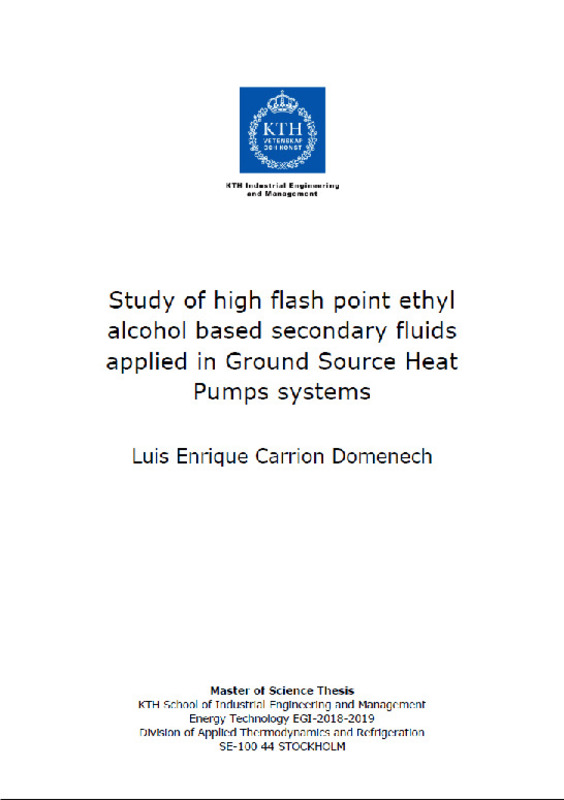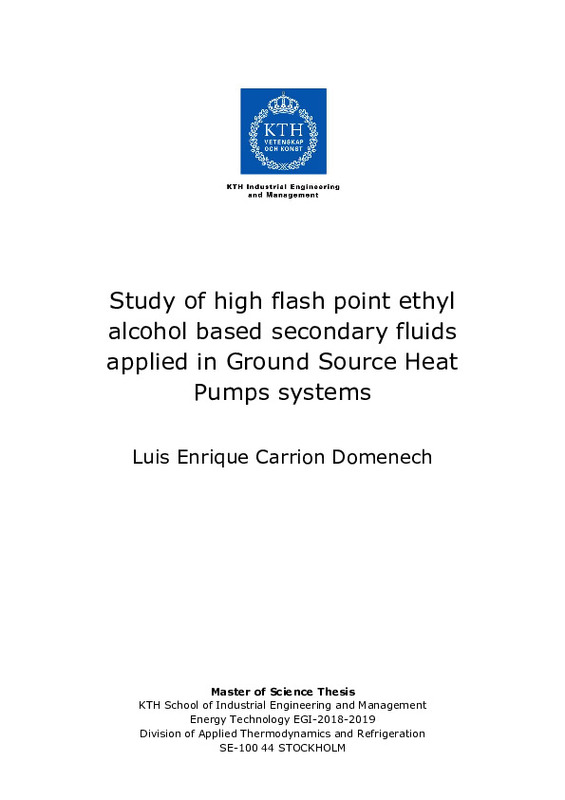JavaScript is disabled for your browser. Some features of this site may not work without it.
Buscar en RiuNet
Listar
Mi cuenta
Estadísticas
Ayuda RiuNet
Admin. UPV
Estudio de fluidos secundarios de base etanol de alto punto de inflamación con aplicación en sistemas de bombas de calor geotérmica
Mostrar el registro sencillo del ítem
Ficheros en el ítem
| dc.contributor.advisor | Corberán Salvador, José Miguel
|
es_ES |
| dc.contributor.author | Carrión Domenech, Luis Enrique
|
es_ES |
| dc.date.accessioned | 2020-06-08T18:15:55Z | |
| dc.date.available | 2020-06-08T18:15:55Z | |
| dc.date.created | 2019-09-27 | |
| dc.date.issued | 2020-06-08 | es_ES |
| dc.identifier.uri | http://hdl.handle.net/10251/145699 | |
| dc.description.abstract | [EN] Ethyl alcohol (ethanol) as secondary fluids is very popular as heat transfer fluid for indirect refrigeration system with ground source heat pump systems (GSHP) in several countries such as Sweden, Norway, Switzerland, Finland and other European countries. There have been several researches about the future of the refrigeration sector, refrigerants and refrigeration systems. Moreover, strict regulations such as F-gas regulation and Kigali Amendment forcing a phase down of many current widely used high global warming potential (GWP) refrigerants, i.e. R134a or R410A. Therefore, secondary refrigeration systems and their working fluids are expected to play a key role in order to minimize the refrigerant charge in the systems, reduce the indirect refrigerant leakages as well as increase the safety during operation. The aim of this thesis is to investigate the effect different additives to increase the flame point together with ethanol-based secondary fluids and validate their thermophysical properties by comparing them with reference values for pure ethanol water solutions. The study aims to design a new commercial ethyl alcoholbased product for GSHP system that could replace existing ones in the Swedish market and could work with natural or flammable low GWP refrigerants. Different high flash point additives were tested such as 1-propyl alcohol, n-butyl alcohol, glycerol and propylene carbonate. Thermophysical properties were investigated and a GSHP model in Excel was created in order to assess the energy performance of the resulted blends. After screening different blends and assessing the energy performance, glycerol as additive in low concentration seems to be the future for the ethyl alcohol-based secondary fluids because of its high flash point (160ºC) that will reduce the flammability risk associated to ethyl alcohol blends, the low viscosity (by 12% lower compared to pure ethyl alcohol blends) that help reduce pumping power by 4.5% compared to pure ethyl alcohol blends. Moreover, ethyl alcohol and glycerol blend showed the lost in heat transfer coefficient by 4% lower compared to pure ethyl alcohol blends due to lower thermal conductivity compared to pure ethyl alcohol blends. Finally, it is a rather cheap and natural product which has no problem related to corrosion since ethyl alcohol and glycerol are less corrosive than water. Although, flash point test was not conducted so there is no data regarding the flash point, it is expected the flash point is increased due to the high flash point of glycerol compared to ethyl alcohol or other possible additives. Therefore, it is expected that the flammability risk associated to ethyl alcohol-based secondary fluids is reduced. | es_ES |
| dc.description.abstract | [ES] Posibilidades para solucionar los desafíos son el usode sistemas indirectos para sistemas de bomba de calor geotérmicas y la búsqueda de fluidos secundarios alternativos. Suecia es el lider en sistemas de bomba de calor de suelo y utilización de energía geotérmica en Europa (Gehlin, Andersson 2016), para las cuales calefacción y refrigeración en edificios son los principales propositos. Entre las opciones, los fluidos secundarios de base ethanol son los fluidos secundarios más comunes en Suecia y otros países escandinavos debido a sus propiedades termofísicas relativamente buenas (Ignatowicz, Mazzotti, Melinder, Palm 2017a). Sin embargo, estos fluidos no pueden exceder 30% en concentración en peso correspondiente a temperatura de congelación de -20.5 ºC por riesgo de inflamación (Melinder 2008). Además, los productos de base etanol comercialmente disponibles en Suecia son distribuidos como 90-95% concentración de etanol, incluyendo hasta un 12% de agentes desanaturalizante sin inhibidores de corrosión. La regulación de la Unión Europea estrictamente define el tipo y concentración de estos agentes usados para evitar que sean ingeridos (Ignatowicz, Mazzotti, Melinder, Palm 2017b). (Ignatowicz, Acuña, Melinder, Palm 2015), (Ignatowicz, Melinder, Palm 2016) and (Ignatowicz, Mazzotti, Melinder, Palm 2017a) muestran que la presencia de estos agentes desnaturalizantes definitivamente mejoran el rendimiento térmico pero no cambian el punto de llama. Por lo tanto, se plantean preguntas sobre si otros aditivos pueden utilizarse junto a etanol para aumentar el punto de llama para que puedan ser usados con otros refrigerantes naturales e inflamables. El objetivo de este Trabajo Final de Master es investigar el efecto de diferentes aditivos para incrementar el punto de llama de fluidos secundarios de base etanol y validar sus propiedades termofísicas comparándolas con valores de referencia mezclas de etanol puro con agua y comerciales. El estudio tiene como objetivo el diseñar un nuevo producto comercial para los sistemas de bomba de calor de suelo que podría reemplazar a los existentes en el mercado sueco. | es_ES |
| dc.description.abstract | [EN] Possibilities to overcome the trial are the use of indirect systems for GSHPs and the search for alternative secondary fluids. Sweden is the leader in GSHP systems and geothermal energy utilization in Europe (Gehlin, Andersson 2016), where heating and cooling in buildings are one of the main purposes. Among other options, ethanol-based secondary fluids are the most common secondary fluids in Sweden and other Scandinavian countries due to their relative good thermophysical properties (Ignatowicz, Mazzotti, Melinder, Palm 2017a). Nevertheless, these fluids are usually not exceeding 30 wt-%, corresponding to a freezing point of -20.5 ºC due to safety regulations and flammability risks (Melinder 2008). In addition, the commercially available ethanol-based products in Sweden are distributed as 90 - 95 wt-% ethanol concentrate, including up to 12 wt-% of denaturing agents but no corrosion inhibitors. European Union regulations strictly define the types and concentrations of the denaturing agents used to prevent from drinking (Ignatowicz, Mazzotti, Melinder, Palm 2017b). (Ignatowicz, Acuña, Melinder, Palm 2015), (Ignatowicz, Melinder, Palm 2016) and (Ignatowicz, Mazzotti, Melinder, Palm 2017a) showed that the presence of denaturing agents definitely improves the thermal performance of ethanol-based secondary fluids but do not change the flame point. Therefore, a question is being raised if other additives could be used together with ethanol in order to rise the flame point so they can be used with natural and flammable refrigerants. The aim of this MSc thesis is to investigate the effect of different additives to increase the flame point together with ethanol-based secondary fluids and validate their thermophysical properties by comparing them with reference values for pure ethanol-water solutions and commercially available ones. The study aims to design a new commercial for GSHP system that could replace existing ones in the Swedish market. | es_ES |
| dc.language | Inglés | es_ES |
| dc.publisher | Universitat Politècnica de València | es_ES |
| dc.rights | Reserva de todos los derechos | es_ES |
| dc.subject | Sistema de refrigeración indirecto | es_ES |
| dc.subject | Fluido secundario | es_ES |
| dc.subject | Sistemas de bomba de calor geotérmica | es_ES |
| dc.subject | Propiedades | es_ES |
| dc.subject | Alcohol | es_ES |
| dc.subject | Inflamabilidad | es_ES |
| dc.subject | Indirect refrigeration system | es_ES |
| dc.subject | Secondary Fluid | es_ES |
| dc.subject | Geothermal Heat Pump systems | es_ES |
| dc.subject | Properties | es_ES |
| dc.subject | Flammability | es_ES |
| dc.subject.classification | MAQUINAS Y MOTORES TERMICOS | es_ES |
| dc.subject.other | Máster Universitario en Ingeniería Industrial-Màster Universitari en Enginyeria Industrial | es_ES |
| dc.title | Estudio de fluidos secundarios de base etanol de alto punto de inflamación con aplicación en sistemas de bombas de calor geotérmica | es_ES |
| dc.type | Tesis de máster | es_ES |
| dc.rights.accessRights | Abierto | es_ES |
| dc.contributor.affiliation | Universitat Politècnica de València. Departamento de Termodinámica Aplicada - Departament de Termodinàmica Aplicada | es_ES |
| dc.contributor.affiliation | Universitat Politècnica de València. Escuela Técnica Superior de Ingenieros Industriales - Escola Tècnica Superior d'Enginyers Industrials | es_ES |
| dc.description.bibliographicCitation | Carrión Domenech, LE. (2019). Estudio de fluidos secundarios de base etanol de alto punto de inflamación con aplicación en sistemas de bombas de calor geotérmica. http://hdl.handle.net/10251/145699 | es_ES |
| dc.description.accrualMethod | TFGM | es_ES |
| dc.relation.pasarela | TFGM\112306 | es_ES |
Este ítem aparece en la(s) siguiente(s) colección(ones)
-
ETSII - Trabajos académicos [9890]
Escuela Técnica Superior de Ingenieros Industriales







